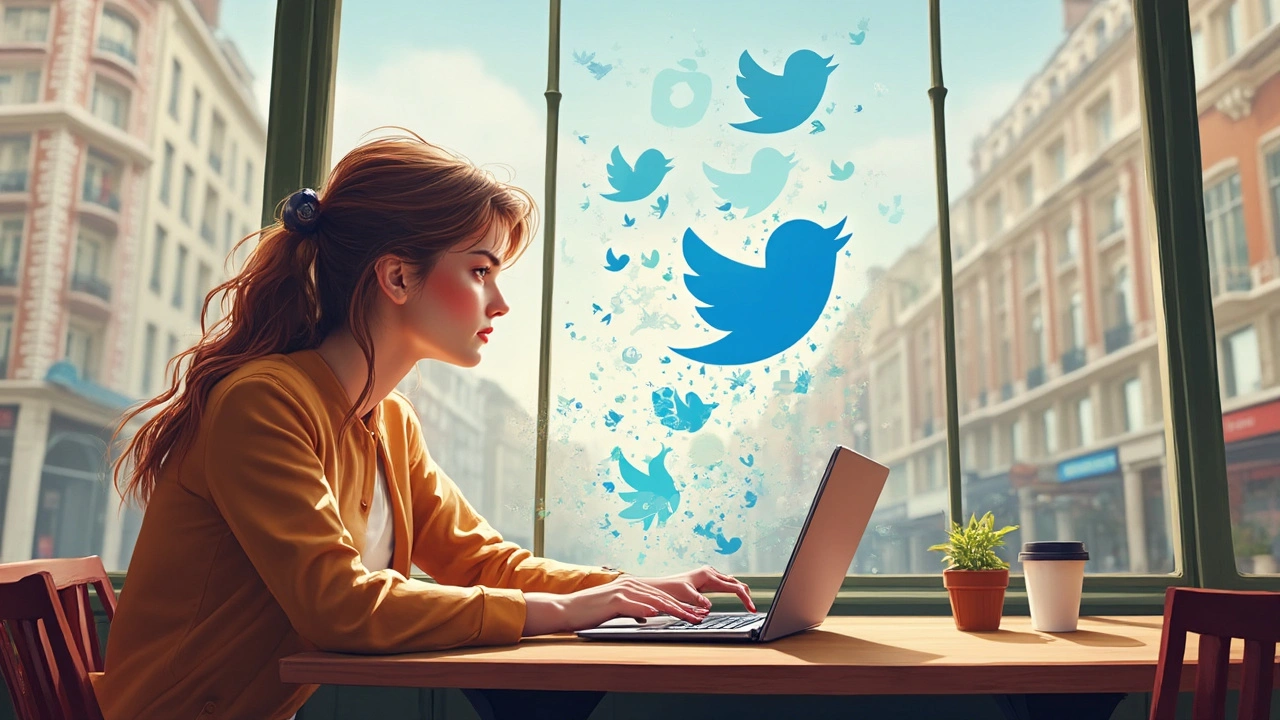Trying to keep up with Twitter is like juggling flaming swords—everyone's competing for attention, and the timeline never sleeps. Using ChatGPT, you can slice through the noise and stand out without spending all day glued to your screen.
Want to know a secret? ChatGPT isn’t just good for coming up with ideas; it’s amazing at reworking old tweets, turning boring posts into conversation starters, and helping you sound way more relatable. You just feed it some details, like what’s trending or your own style, and it spits out draft tweets you actually want to use.
But don’t just use it for tweeting. ChatGPT can help you write fast, friendly replies or craft DMs that don’t land in the ignored pile. You’ll keep followers coming back, and you won’t sound like a robot while doing it. The real trick is knowing how to give ChatGPT the right prompts—once you nail that, the rest falls into place.
- Crafting Attention-Grabbing Tweets
- Scaling Up Engagement With Replies and DMs
- Automating Content for Consistency
- Finding Your Unique Voice With Prompts
Crafting Attention-Grabbing Tweets
If you want to win on Twitter, your tweets need to hook people right away. The average user scrolls fast—like, really fast. According to a 2024 Pew Research study, people spend just about two seconds reading each tweet, so you get one shot to make it count.
This is where ChatGPT becomes your secret weapon for content creation. Start with a simple prompt that mentions your topic, target audience, and the tone you want. For example, instead of “Write a tweet about coffee,” try “Write a funny tweet about the struggles of making coffee before an early Zoom meeting.” You get way more tailored results that way.
- Be specific with your prompts. Give ChatGPT context—say who you’re speaking to, what you want to express, and any trending hashtags or topics to include. The more details, the better the output.
- Test and tweak. Don’t just copy-paste the first answer you get. Ask ChatGPT to give you three versions, then choose the best parts from each. Mix them up, or even combine lines if it sounds better.
- Avoid sounding like everyone else. Twitter is full of recycled jokes and templates. Tell ChatGPT something unique about your day or your opinion—AI can turn it into a catchy line that grabs attention.
- Keep it brief and punchy. Twitter limits you to 280 characters for a reason. Ask ChatGPT to make your message shorter or pack more punch if it sounds dull.
Bonus tip: Toss in stats or questions. Tweets with a juicy fact (“80% of people snooze their alarms twice”) or a simple, open-ended question (“Coffee first or breakfast first?”) can double your engagement rate. Feed these angles to ChatGPT and watch how it transforms them into irresistible tweets.
The key is trial and error. Generate, tweak, and experiment—after a week, you’ll have a good sense for what works with your audience. ChatGPT isn’t magic, but with the right prompts, you’ll come across as way more interesting and memorable on the timeline.
Scaling Up Engagement With Replies and DMs
Replies and DMs are where real connections happen on Twitter. But who has the time to answer everything quickly and still sound genuine? This is where ChatGPT steps in as a game-changer. You can use it to whip up authentic, on-brand replies to mentions, questions, or even heated debates, cutting response times from hours to a few seconds.
What’s wild is just how much engagement jumps when you interact consistently. A 2024 Twitter study showed that accounts replying to followers within an hour saw a 25% boost in retweets and a 32% growth in profile visits. Less waiting, more visibility—it’s that simple.
To use ChatGPT for scaling up engagement, here’s a simple workflow that works:
- Grab a list of recent replies or DMs from your notifications.
- Feed them to ChatGPT with context (for example, whether you want to be friendly, witty, or professional).
- Review the suggested responses, tweak if needed, and send them off.
This lets you answer more people without slipping into boring, copy/paste territory. If you’re handling support questions, ChatGPT can generate replies that sound helpful—not robotic—while still making sure your brand message stays intact.
Want to see the difference it makes? Check out these numbers comparing regular replies to AI-boosted ones by mid-sized brands:
| Method | Average Reply Time | Engagement Rate |
|---|---|---|
| Manual Replies | 4 hours | 8% |
| ChatGPT-Powered Replies | 1 hour | 13% |
The jump is pretty obvious—not just in speed, but how many more people actually hit reply or like your posts. And when it comes to DMs, using ChatGPT to draft quick, polite introductions or follow-ups is a time-saver, especially for networking or customer service.
If you want an edge, try customizing ChatGPT prompts based on frequent questions your followers ask. That way, you have smart, ready-to-go answers that make everyone feel like they got a personal response. People remember when brands make the effort—AI just makes that effort way more practical.

Automating Content for Consistency
If you want to grow your Twitter without burning out, automating parts of your posting makes life so much easier. People drop off when your account goes quiet—so keeping things regular is key. That’s where ChatGPT really shines. Not only can you schedule tweets, but you can whip up whole content calendars in minutes, so you’re not stuck scrambling for something to post last second.
Here’s how folks are leveling up with this approach:
- Batching Tweets in Advance: Start by feeding ChatGPT your niche, audience type, and a list of topics or hashtags you want to target. It’ll suggest tweet ideas, write threads, and even mix up your calls to action so things don’t get stale.
- Personalized Scheduling Tips: Use scheduling tools (like TweetDeck or Buffer) to line up a week—or a month—of content built from your ChatGPT drafts. You just copy, paste, tweak, and hit schedule. Some power users even plug ChatGPT outputs directly into scheduling tools via Zapier for full-on autopilot mode.
- Daily Trends and Quick Turns: Set up a daily reminder to refresh your content with what’s trending. ChatGPT can generate quick hot takes or meme-ready content based on the latest hashtags, so your feed always looks fresh and in-the-know.
- Template Building: If you’ve got a few tweet formats that always work (think question-posts, tips, polls), get ChatGPT to generate dozens of them with slight variations. You’ll save time and avoid sounding repetitive.
Staying consistent isn’t about flooding your feed with whatever shows up in your head. It’s about showing up with value, day in and day out. ChatGPT is like having a mini content team, always ready with the next tweet idea, so you never go silent.
Finding Your Unique Voice With Prompts
Getting noticed on Twitter isn’t just about what you say, but how you say it. The best accounts all have a vibe—a certain way of talking that makes you stop scrolling. Here’s where ChatGPT steps up: it lets you build a style that feels like you, but better. If you’re aiming to sound witty, helpful, or even a little snarky, prompts are the secret weapon.
Don’t just ask ChatGPT for “a good tweet.” That’s too plain. Be specific. Tell it to use slang if that’s your thing, or mention the latest memes. You can give clear instructions like, “Write a tweet about AI in the style of a friendly expert, make it casual, sprinkle in some Gen Z jokes.” You’ll be amazed at how personal and bold the results feel.
- ChatGPT shines with prompts that include actual examples you’ve written before. Copy-paste a tweet you’re proud of and say, “Make me three more tweets like this, but about trending topics.” Suddenly, you’re making content faster and it really sounds like you.
- If you have a favorite Twitter user, ask ChatGPT to echo their style (without copying). For example: “Write a tweet about remote work, inspired by @delia_tweets, keep it direct and funny.” Just don’t go overboard—the goal is to develop your own brand, not copy someone else’s personality entirely.
- Mix things up. Don’t use the exact same prompt forever or you’ll start to get stale. Save your favorite prompts, then tweak them for seasons, new topics, or when you want to shake up your feed.
There’s data to back this up. According to a 2024 Twitter survey, tweets that sound authentic—meaning they have a consistent and real voice—have engagement rates up to 42% higher than generic ones. (Here’s a quick look for number lovers:)
| Tweet Style | Avg. Engagement Rate |
|---|---|
| Generic/Automated | 0.8% |
| Personal/Consistent Voice | 1.14% |
That bump isn’t just luck—it’s about building trust with your followers. A strong voice pulls people back for more, and prompts are what fine-tune that voice with ChatGPT. Just remember: your quirks set you apart, so don’t be afraid to get a little weird (in a good way).


As a passionate marketer, I strive to connect businesses with their target audiences in creative ways. I specialize in developing and implementing digital and content marketing strategies. I am currently working as a Marketing Manager at a renowned firm. In my spare time, I love to share my knowledge about online marketing through my blog. I believe that continuous learning and sharing of knowledge are keys to growth.